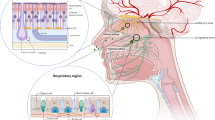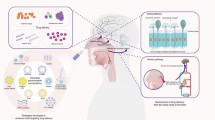Abstract
Intranasal drug administration is a noninvasive method of bypassing the blood–brain barrier (BBB) to deliver neurotrophins and other therapeutic agents to the brain and spinal cord. This method allows drugs that do not cross the BBB to be delivered to the central nervous system (CNS) and eliminates the need for systemic delivery, thereby reducing unwanted systemic side effects. Delivery from the nose to the CNS occurs within minutes along both the olfactory and trigeminal neural pathways. Intranasal delivery occurs by an extracellular route and does not require that drugs bind to any receptor or undergo axonal transport. Intranasal delivery also targets the nasal associated lymphatic tissues (NALT) and deep cervical lymph nodes. In addition, intranasally administered therapeutics are observed at high levels in the blood vessel walls and perivascular spaces of the cerebrovasculature. Using this intranasal method in animal models, researchers have successfully reduced stroke damage, reversed Alzheimer’s neurodegeneration, reduced anxiety, improved memory, stimulated cerebral neurogenesis, and treated brain tumors. In humans, intranasal insulin has been shown to improve memory in normal adults and patients with Alzheimer’s disease. Intranasal delivery strategies that can be employed to treat and prevent NeuroAIDS include: (1) target antiretrovirals to reach HIV that harbors in the CNS; (2) target therapeutics to protect neurons in the CNS; (3) modulate the neuroimmune function of moncyte/macrophages by targeting the lymphatics, perivascular spaces of the cerebrovasculature, and the CNS; and (4) improve memory and cognitive function by targeting therapeutics to the CNS.
Similar content being viewed by others
References
Alcalay RN, Giladi E, Pick CG, Gozes I (2004) Intranasal administration of NAP, a neuroprotective peptide, decreases anxiety-like behavior in aging mice in the elevated plus maze. Neurosci Lett 361:128–131
Banks WA, During MJ, Niehoff ML (2004) Brain uptake of the glucagon-like peptide-1 antagonist exendin(9–39) after intranasal administration. J Pharmacol Exp Ther 309:469–475
Benedict C, Hallschmid M, Hatke A, Schultes B, Fehm HL, Born J, Kern W (2004) Intranasal insulin improves memory in humans. Psychoneuroendocrinology 29:1326–1334
Born J, Lange T, Kern W, McGregor GP, Bickel U, Fehm HL (2002) Sniffing neuropeptides: a transnasal approach to the human brain. Nat Neurosci 5:514–516
Capsoni S, Giannotta S, Cattaneo A (2002) Nerve growth factor and galantamine ameliorate early signs of neurodegeneration in anti-nerve growth factor mice. Proc Nat Acad Sci USA 99:12432–12437
Chen XQ, Fawcett JR, Rahman YE, Ala TA, Frey WH II (1998) Delivery of nerve growth factor to the brain via the olfactory pathway. J Alzheimer’s Dis 1:35–44
da Fonseca CO, Landeiro JA, Clark SS, Quirico-Santos T, da Costa Carvalho Mda G, Gattass CR (2006) Recent advances in the molecular genetics of malignant gliomas disclose targets for antitumor agent perillyl alcohol. Surg Neurol 65 S1:2–1:9
De Rosa R, Garcia AA, Braschi C, Capsoni S, Maffei L, Berardi N, Cattaneo A (2005) Intranasal administration of nerve growth factor (NGF) rescues recognition memory deficits in AD11 anti-NGF transgenic mice. Proc Natl Acad Sci USA 102:3811–3816
Dhanda DS, Frey WH 2nd, Leopold D, Kompella UB (2005) Approaches for drug deposition in the human olfactory epithelium. Drug Deliv Technol 5:64–72
Dou H, Kingsley JD, Mosley RL, Gelbard HA, Gendelman HE (2004) Neuroprotective strategies for HIV-1 associated dementia. Neurotox Res 6:503–521
Draghia R, Caillaud C, Manicom R, Pavirani A, Kahn A, Poenaru L (1995) Gene delivery into the central nervous system by nasal instillation in rats. Gene Ther 2:418–23
During MJ, Cao L, Zuzga DS, Francis JS, Fitzsimons HL, Jiao X, Bland RJ, Klugmann M, Banks WA, Drucker DJ, Haile CN (2003) Glucagon-like peptide-1 receptor is involved in learning and neuroprotection. Nature Med 9:1173–1179
Frey WH 2nd (1991) Neurologic agents for nasal administration the brain. World Intellectual Property Organization. PCT priority date 5.12.89, WO 91/07947
Frey WH 2nd (2002) Bypassing the blood–brain barrier to delivery thereapeutic agents to the brain and spinal cord. Drug Deliv Technol (5):46–49
Frey WH 2nd, Liu, J, Chen, X, Thorne, RG, Fawcett, JR, Ala, TA, Rahman, Y-E (1997) Delivery of 125I-NGF to the brain via the olfactory route. Drug Deliv 4:87–92
Gimenez F, Fernandez C, Mabondzo A (2004) Transport of HIV protease inhibitors through the blood–brain barrier and interactions with the efflux proteins, P-glycoprotein and multidrug resistance proteins. J Acquir Immune Defic Syndr 36:649–58
Gozes I, Zamostiano R, Pinhasov A, Bassan M, Giladi E, Steingart RA, Brenneman DE (2000) A novel VIP responsive gene. Activity dependent neuroprotective protein. Ann NY Acad Sci 921:115–118
Graff CL, Pollack GM (2003) P-glycoprotein attenuates brain uptake of substrates after nasal instillation. Pharm Res 20:1225–1230
Graff CL, Pollack GM (2005) Functional evidence for P-glycoprotein at the nose–brain barrier. Pharm Res 22:86–93
Hallschmid M, Benedict C, Schultes B, Fehm HL, Born J, Kern W (2004) Intranasal insulin reduces body fat in men but not in women. Diabetes 53:3024–3029
Hallschmid M, Smolnik R, McGregor G, Born J, Fehm HL (2006) Overweight humans are resistant to the weight-reducing effects of melanocortin4–10. J Clin Endocrinol Metab 91:522–525
Hanson LR, Martinez PM, Taheri S, Kamsheh L, Mignot E, Frey WH 2nd (2004) Intranasal administration of hypocretin 1 (orexin A) bypasses the blood–brain barrier and targets the brain: a new strategy for the treatment of narcolepsy. Drug Delive Technol 4:65–71
Hashizume R, Ozawa T, Gryaznov SM, Santos RA, Lamborn KR, Frey WH 2nd, Deen DF (2006) Intranasal delivery of specific telomerase inhibitor GRN163 in human glioblastoma xenografts. American Association of Neurological Surgeons Abstract: 2006 Apr 24
Heseltine PN, Goodkin K, Atkinson JH, Vitello B, Rochon J, Heaton RK, Eaton EM, Wilkie FL, Sobel E, Brown SJ, Feaster D, Schneider L, Goldschmidts WL, Stover ES (1998) Randomized double-blind placebo-controlled trial of peptide T for HIV-associated cognitive impairment. Arch Neurol 55:41–51
Jerusalmi A, Morris-Downes MM, Sheahan BJ, Atkins GJ (2003) Effect of intranasal administration of Semliki Forest virus recombinant particles expressing reporter and cytokine genes on the progression of experimental autoimmune encephalomyelitis. Mol Ther 8:886
Jin K, Xie L, Childs J, Sun Y, Mao XO, Logvinova A, Greenberg DA (2003) Cerebral neurogenesis is induced by intranasal administration of growth factors. Ann Neurol 53:405–409
Kandimalla KK, Donovan MD (2005a) Localization and differential activity of P-glycoprotein in the bovine olfactory and nasal respiratory mucosae. Pharm Res 22:1121–1128
Kandimalla KK, Donovan MD (2005b) Carrier mediated transport of chlorpheniramine and chlorcyclizine across bovine olfactory mucosa: implications on nose-to-brain transport. J Pharm Sci 94:613–624
Koenig S, Gendelman HE, Orenstein JM, Dal Canto MC, Pezeshkpour GH, Yungbluth M, Janotta F, Aksamit A, Martin MA, Fauci AS (1986). Detection of AIDS virus in macrophages in brain tissue from AIDS patients with encephalopathy. Science 233:1089–93
Kosfeld M, Heinrichs M, Zak PJ, Fischbacher U, Fehr E (2005) Oxytocin increases trust in humans. Nature 435(7042):673–676
Laing JM, Gober MD, Golembewski EK, Thompson SM, Gyure KA, Yarowsky PJ, Aurelian L (2006) Intranasal administration of the growth-compromised HSV-2 vector DeltaRR prevents kainate-induced seizures and neuronal loss in rats and mice. Mol Ther 13(5):870–881
Lemiale F, Kong WP, Akyurek LM, Ling X, Huang Y, Chakrabarti BK, Eckhaus M, Nabel GJ (2003) Enhanced mucosal immunoglobulin A response of intranasal adenoviral vector human immunodeficiency virus vaccine and localization in the central nervous system. J Virol 77:10078–10087
Liu XF, Fawcett JR, Hanson LR, Frey WH 2nd (2004) The window of opportunity for treatment of focal cerebral ischemic damage with noninvasive intranasal insulin-like growth factor-I in rats. J Stroke Cerebrovasc Dis 13:16–23
Panter SS, Coppes VG, Ferrell CM, Chavez JC, Ratan RR, Frey WH 2nd (2004) Intranasal deferoxamine protects against subsequent stroke. Program No. 456.15.2004 Abstract Viewer/Itinerary Planner. Washington, DC: Society for Neuroscience
Pereira CF, Nottet HLSM (2000) The blood–brain barrier in HIV-associated Dementia. NeuroAids 3(2), online
Polianova MT, Ruscetti FW, Pert CB, Tractenberg RE, Leoung G, Strang S, Ruff MR (2003) Antiviral and immunological benefits in HIV patients receiving intranasal peptide T (DAPTA). Peptides 24:1093–1098
Reger MA, Watson GS, Frey WH 2nd, Baker LD, Cholerton B, Keeling ML, Belongia DA, Fishel MA, Plymate SR, Schellenberg GD, Cherrier MM, Craft S (2006) Effects of intranasal insulin on cognition in memory-impaired older adults: modulation by APOE genotype. Neurobiol Aging 27:451–458
Ross TM, Martinez PM, Renner JC, Thorne RG, Hanson LR, Frey WH 2nd (2004) Intranasal administration of interferon beta bypasses the blood–brain barrier to target the central nervous system and cervical lymph nodes: a non-invasive treatment strategy for multiple sclerosis. J Neuroimmunol 151:66–77
Ruff MR, Polianova M, Pert CB, Ruscetti FW (2001) Peptide T inhibits HIV-1 infection mediated by the chemokine receptor-5 (CCR5). Antiviral Res 52–63
Ruff MR, Polianova M, Yang QE, Leoung GS, Ruscetti FW, Pert CB (2003) Update on D-ala-peptide T-amide (DAPTA): a viral entry inhibitor that blocks CCR5 chemokine receptors. Curr HIV Res 1:51–67
Schulz C, Paulus K, Lehnert H (2004) Central nervous and metabolic effects of intranasally applied leptin. Endocrinol 145:2696–2701
Shimizu H, Oh-I S, Okada S, Mori M (2005) Inhibition of appetite by nasal leptin administration in rats. Int J Obes 29:858–863
Shingaki T, Sakane T, Yamashita S, Sezaki H, Tokunaga Y, Shibata S (1999) Transnasal delivery of anticancer drugs to the brain tumors: a new strategy for brain tumor chemotherapy. Drug Deliv Syst 14:365–371
Thorne, RG, Frey WH 2nd (2001) Delivery of neurotrophic factors to the central nervous system: pharmacokinetic considerations. Clin Pharmacokinet 40:907–946
Thorne RG, Pronk GJ, Padmanabhan V, Frey WH 2nd (2004) Delivery of insulin-like growth factor-I to the rat brain and spinal cord along olfactory and trigeminal pathways following intranasal administration. Neuroscience 127:481–96
Vazeux R, Brousse N, Jarry A, Henin D, Marche C, Vedrenne C, Mikol J, Wolff M, Michon C, Rozenbaum W, Bureau JF, Montagnier L, Brahic M (1987). AIDS subacute encephalitis. Identification of HIV-infected cells. Am J Pathol 126:403–410
Wang D, Gao Y, Yun L (2005) Study on brain targeting of raltitrexed following intranasal administration in rats. Cancer Chemother Pharmacol 57:97–104
Wang F, Jiang XG, Lu W (2004) Intranasal delivery of methotrexate to the brain in rats bypassing the blood–brain barrier. Drug Deliv Technol 4:48–55
Wiley CA, Schrier RD, Nelson JA, Lampert PW, Oldstone MB (1986) Cellular localization of human immunodeficiency virus infection within the brains of acquired immune deficiency syndrome patients. Proc Natl Acad Sci USA 83:7089–7093
Yu YP, Xu QQ, Zhang Q, Zhang WP, Zhang LH, Wei EQ (2005) Intranasal recombinant human erythropoietin protects rats against focal cerebral ischemia. Neurosci Lett 387:5–10
Acknowledgment
This study was supported by a grant from the NIH to W.H.F. (MH072473).
Author information
Authors and Affiliations
Corresponding author
Rights and permissions
About this article
Cite this article
Hanson, L.R., Frey, W.H. Strategies for Intranasal Delivery of Therapeutics for the Prevention and Treatment of NeuroAIDS. Jrnl Neuroimmune Pharm 2, 81–86 (2007). https://doi.org/10.1007/s11481-006-9039-x
Received:
Accepted:
Published:
Issue Date:
DOI: https://doi.org/10.1007/s11481-006-9039-x




